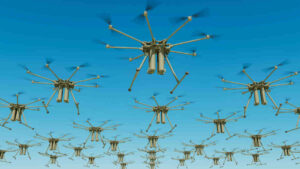‘Houston we have a problem’: Not enough Aussie companies getting in on the space action

Pic: gorodenkoff / iStock / Getty Images Plus via Getty Images
The 50th anniversary of the moon landing is spurring a new space race and Australia is firing on all cylinders in a bid to be a contender.
The Australian Space Agency, which just celebrated its first birthday, is on the hunt for companies well positioned to showcase Australia’s space capabilities on the world stage.
The ASA’s goal is to grow the domestic space sector from $3.9 billion to $12 billion over the next 10 years and create up to 20,000 new space jobs.
From 2008 until July last year, Australia was the only OECD country without a space agency, with the previous Australian Space Office disbanded by the federal government in 1996.
“I suppose the 50th anniversary of the moon landing and the sudden interest in the moon again has propped up a lot of ideas that are probably a lot more viable now that there is real competition,” Philippe Odouard, managing director of XTEK (ASX:XTE), told Stockhead.
“The Indians and the Chinese want to have someone or something on the moon pretty quickly too. There is a moon race again like it used to be 50 years ago.”
XTEK has a processing technology that allows it to make things lighter and stronger – which is good news for anyone wanting to send stuff into space because it’s pretty pricey.
The company’s bread and butter is military, specifically ballistics, protection, but it is taking a sidestep into the space industry due to growing demand.
And just last week the ASA inked a cooperation agreement with XTEK.
- Subscribe to our daily newsletter
- Join our small cap Facebook group
- Follow us on Facebook or Twitter
ASA head Dr Megan Clark said the collaboration would assist in the development of space-related industries in Australia and highlighted how manufacturing companies could diversify their activities into the growing space sector.
The global commercial satellite imaging market in particular is proving to be a lucrative field, with predictions it will climb more than 86 per cent from 2017 to $US6.8 billion in the next four years.
XTEK is seeing increasing interest from satellite companies and in mid-June entered into an MoU with Canberra-based space services company Skykraft.
The two companies will work together to co-engineer spacecraft and launcher structures.
Odouard said Skykraft made micro-satellites that right now have an aluminium structure, which is heavy and expensive.
“When you have to put a satellite in orbit, every gram is costing a huge amount,” he said. “So if you can save 30 to 40 per cent of the weight, it’s just massive.”
Could space mining really become a thing?
The UK seems to think so. Researchers at the University of Edinburgh have sent prototype “space mining” kits to the International Space Station to study how microscopic organisms could be used to recover minerals and metals from space rocks.
According to researchers, tests will reveal how low gravity affects bacteria’s natural ability to extract useful materials – such as iron, calcium and magnesium – from rocks.
Eighteen of the devices are being transported to the International Space Station aboard a SpaceX rocket, which launched last week from Cape Canaveral in Florida, US.
Researchers say the ground-breaking study could aid efforts to establish manned settlements on distant worlds by helping develop ways to source minerals essential for survival in space.
But it has taken 10 years for these matchbox-sized prototypes – called biomining reactors – to come to fruition.
That begs the question: how quickly can Australia become a serious contender in the space race?
“These are factors that are all very positive and there are some real means to do it,” Odouard said.
“I think it’s of the utmost interest, but before you go from a scientific or curiosity side of things to real business, it might take some time.
“SpaceX has managed to do it in a few years, so there’s definitely potential. How fast is really the question business-wise.”
Although XTEK hasn’t really discussed too much the option of helping mining become a reality in space, it is something the company would consider if the opportunity arose.
“The concept in itself is understood, I’m not sure if it’s for tomorrow, but to get those machines onto the moon they will have to be produced here on Earth … and that’s where we can bring a lot of value in,” Odouard said.
“If someone comes to us and says ‘we’d like a machine to do this kind of thing, how can we make it lighter?’, we definitely have a solution.”
Not many Aussie players
Right now Australia can count the number of listed space stocks it has on one hand.
Craig Smith, the chief of space and defence company Electro Optic Systems (ASX:EOS), told Stockhead late last year that the development of a domestic space industry was long overdue.
Electro Optic Systems is one of the ASX’s few genuine space stocks along with Sky and Space Global (ASX:SAS), makers of nanosatellites for telecommunications, and space surveillance company Kleos Space (ASX:KSS), which made its debut on the ASX in August last year.
Electro Optic Systems provides an array of services to the Australian space industry, from space debris and satellite tracking to powerful telescopes, research and satellite laser ranging.
UNLOCK INSIGHTS
Discover the untold stories of emerging ASX stocks.
Daily news and expert analysis, it's free to subscribe.
By proceeding, you confirm you understand that we handle personal information in accordance with our Privacy Policy.








